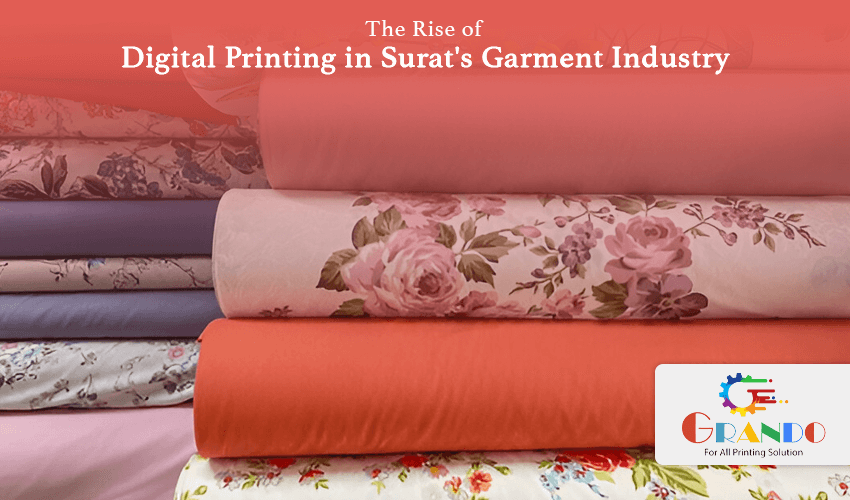
If you’ve spent any time in Surat — the textile capital of India — you know that fabric is more than just a business here. It’s a way of life, a culture, and, let’s be honest, a bit of a competitive sport. For decades, Surat has dazzled the world with its intricate handwork — from zardozi to bandhani — but hold onto your dye pots, because the game is changing fast.
Digital printing has emerged as a significant shift in the textile industry. Equipped with modern digital printing machines, this technology is steadily replacing the traditional methods that require extensive manual labor. The increasing search for “digital printing near me” shows the growing demand for faster, more efficient, and sustainable production practices in the textile industry.
What is Digital Printing?
Digital Printing Machine refers to the process of transferring digital images directly onto various media substrates. In the textile realm, this involves using inkjet technology to print designs onto fabrics without the need for traditional printing plates. This method allows for:
Customization: Tailored designs catering to specific client needs.
Efficiency: Reduced turnaround times compared to conventional methods.
Eco-friendliness: Minimal waste production and lower water usage.
Unlike traditional techniques that require extensive setup and are cost-effective only for large batches, digital printing offers flexibility for both small and large-scale productions.
Why is Surat Transitioning from Handwork to Digital Printing with Strategic Initiatives?
Surat’s textile industry is evolving, and digital printing is leading the charge. But why now? And why so fast? Let’s dive in:
1. Technological Advancements
If you’ve ever asked, “What is digital printing?”—think of it as the Tesla of textile production. Digital printing machines can print intricate designs directly onto fabrics with precision and speed. Unlike traditional block or screen printing, there’s no need for time-consuming setup or messy color mixing.
2. Consumer Demand for Personalization
Customers today want unique designs, not your average cookie-cutter prints. With digital printing, manufacturers can produce small runs, personalized patterns, and even one-off designs without breaking the bank. That’s music to the ears of fashionistas and boutique labels alike.
3. Sustainability Goals
Traditional printing methods guzzle water and chemicals like it’s going out of style. Digital printing, on the other hand, uses less water, fewer chemicals, and produces less waste. It’s a win-win for businesses and the environment.
4. Strategic Initiatives
The local government and industry bodies like the Surat Textile Cluster Development Association are rolling out training programs, subsidies, and workshops to help artisans and manufacturers adopt digital printing services. That’s not just a trend — that’s a full-on, planned evolution.
The Advantages of Digital Printing in Surat
Here’s why digital printing is reshaping Surat’s garment industry:
- Speed and Efficiency
Ever tried to produce a thousand meters of printed fabric by hand? Yeah, it’s slow. Digital printing machines can churn out intricate designs in hours instead of days. That means manufacturers can react faster to trends — a huge plus in the world of fast fashion.
- Cost-Effective for Short Runs
Producing small batches used to be prohibitively expensive for small designers or new brands. With digital printing, short runs are not only feasible but also cost-effective. That’s why “digital printing near me” is the magic phrase for local startups trying to make it big.
- Design Flexibility
Digital printing allows for endless experimentation — multiple colorways, intricate patterns, gradients — all with a click of a button. Creativity has never been easier (or more enjoyable).
- Quality and Precision
Say goodbye to misaligned prints and blurry edges. Digital printing delivers consistent quality, time after time. For exporters, that’s the difference between winning and losing a contract.
Challenges Facing the Shift
Of course, no revolution is without its hurdles. Here’s where the road gets bumpy:
- Capital Investment
Digital printing machines are not cheap, and small businesses may find the initial investment challenging, even if the long-term benefits are clear.
- Skill Gaps
Operating a digital printing machine requires technical know-how, which differs significantly from traditional methods. Training is essential, and while Surat’s strategic initiatives are addressing this, there is still a long way to go.
- Maintenance and Technical Know-How
Digital printing machines require regular maintenance, software updates, and technical oversight to function efficiently. This can be demanding, especially for small businesses or those new to the technology.
The Future of Digital Printing in Surat
The trajectory suggests a continued rise in digital printing adoption:
Integration with E-commerce: As online shopping grows, the demand for unique, customizable garments will surge, further emphasizing the need for digital printing.
Technological Advancements: Ongoing research and development will lead to more efficient and cost-effective digital printing solutions.
Global Collaborations: Partnerships with international firms can bring in expertise and open up new markets for Surat’s textile products.
Conclusion
Digital printing isn’t just a trend in Surat’s garment industry — it’s a full-blown revolution. By embracing technology, the city’s textile sector enhances creativity, boosts productivity, and aligns with global sustainability goals. It’s a transformative phase that’s reshaping the future of fashion in one of India’s most dynamic textile hubs.
